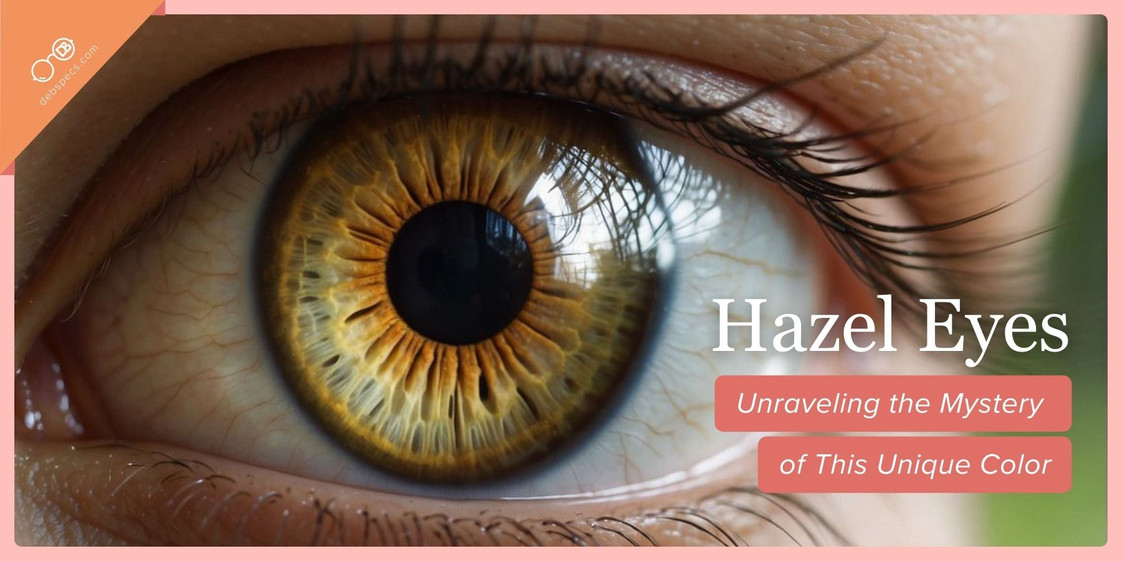
Hazel Eyes: Unraveling the Mystery of This Unique Color
Posted by Team Debby on 2nd Jan 2024
Hazel Eyes: The Most Mysterious Eye Color, Explained
Hazel eyes are like nature’s jewelry box—a shifting mix of gold, green, and brown that seems to change with your mood, your outfit, or even the weather. But what makes hazel eyes so unique? Let’s explore the science, myths, and style tips behind this captivating eye color—and help you find eyewear that makes them shine.
What Color Are Hazel Eyes?
Hazel eyes aren’t just “green” or “brown”—they’re a dynamic fusion of tones. Most hazel eyes feature:
- A golden or amber ring near the pupil
- A green or light brown outer ring
- Flecks or speckles that sparkle in different light
✨ Fun fact: Hazel eyes are often confused with green eyes, but they’re far more complex—and much rarer.
How Rare Are Hazel Eyes?
Only about 5–8% of the global population has hazel eyes. In the U.S., though, they’re more common—around 18%.
- Most common: United States and Europe (especially Spain, the UK, and Germany)
- Rare: Asia and Africa
- Very rare: Northern climates with little sunlight
The Genetics Behind Hazel Eyes (Made Simple)
Hazel eyes are polygenic—influenced by multiple genes, not just one “eye color gene.” The key players are:
- OCA2 + HERC2 genes: Control how much melanin (pigment) is in the iris.
- Melanin types:
- Eumelanin → brown tones
- Pheomelanin → amber or golden tones
The way these pigments mix, plus the way light scatters through the iris (called Rayleigh scattering), creates that color-shifting hazel sparkle.
Think of it as the ultimate genetic remix.
Why Do Hazel Eyes Look Like They Change Color?
Hazel eyes are famous for their chameleon effect—but it’s not magic, it’s biology. They appear to shift depending on:
- Lighting: Natural sunlight vs. indoor light
- Surrounding colors: Clothes, makeup, even room decor
- Emotional state: When pupils dilate, it can alter how the colors appear
That reflective quality makes hazel eyes incredibly versatile—they pick up tones from what you’re wearing, like a built-in style accessory.
Myths vs. Facts About Hazel Eyes
Myth: Hazel eyes permanently change color.
Fact: They only appear different based on light and surroundings.
Myth: Hazel eyes are just green eyes.
Fact: Hazel eyes include more gold and brown tones than true green eyes.
Myth: Eye color predicts personality.
Fact: Genetics, not astrology, determine eye color.
FAQs About Hazel Eyes
Are hazel eyes more sensitive to light?
Sometimes. They may have slightly less natural protection than dark brown eyes. Sunglasses (especially polarized ones) help reduce glare.
Do hazel eyes need special vision care?
Nope—just the same care as any other color.
Can two brown-eyed parents have a child with hazel eyes?
Yes. Eye color inheritance is complex, and recessive genes can create surprise combinations.
Best Eyeglass Frame Colors for Hazel Eyes
Hazel eyes are the ultimate style chameleons, so many frames work beautifully. To highlight their depth:
- Deep green → Brings out green flecks
- Gold → Enhances amber tones
- Tortoise → Matches their multi-tonal mix
- Clear → Lets your eyes take center stage
- Plum/Burgundy → Adds contrast and richness
? Style tip: Choose frames with warm undertones to complement hazel’s golden glow.
Hazel Eyes at a Glance
✔️ Only 5–8% of people have them
✔️ Caused by a mix of melanin + light scattering
✔️ Known for a color-shifting effect
✔️ Enhanced by warm-tone eyeglass frames
✔️ One of the most versatile and expressive eye colors
TL;DR
Hazel eyes are a rare blend of green, gold, and brown that appear to change with light and surroundings. Their unique look comes from genetics and light scattering—not magic. To make them stand out, choose eyewear in warm tones like gold, tortoise, or deep green.
Show Off Your Hazel Eyes with the Right Frames
Your hazel eyes already turn heads—why not frame them in style? Whether you’re shopping for blue light glasses, chic readers, or everyday prescription frames, DebbySpecs has a curated collection designed to complement your sparkle.
? [Browse Eyewear for Hazel Eyes]

